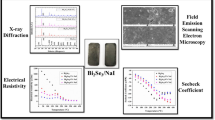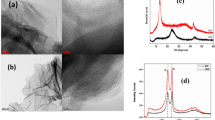Abstract
Inorganic thermoelectric materials are typically brittle and unrecyclable. Among these inorganic thermoelectric materials, antimony selenide (Sb2Se3) is a promising material for preparing topological insulators and photovoltaic devices. Sb2Se3 has a large Seebeck coefficient and extremely low electrical conductivity. To apply Sb2Se3 as a thermoelectric material, its electrical conductivity must be improved, and self-healing must be realized. In this study, we fabricated self-healing thermoelectric composites using liquid metals from Ga–Sn and Sb2Se3 thermoelectric materials. Sb2Se3 nanowires and nanosheets were fabricated through hydrothermal reactions. To improve the thermoelectric performance, the Sb2Se3 nanowire and nanosheet samples were doped with elemental boron. B-doping enhanced both carrier concentration and the carrier mobility, leading to improved electrical conductivity and Seebeck coefficient. The composite material with the highest thermoelectric performance was identified by adjusting the ratio of Sb2Se3 nanowires to nanosheets. Subsequently, a liquid metal alloy Ga–Sn was prepared to achieve a melting point of 166 °C. Furthermore, a Ga–Sn and Sb2Se3 hybrid composite with a weight ratio of 5:5 was prepared through hot pressing at 130 °C (temperature lower than the melting point). The fabricated composite was cut into two pieces and heated to approximately 130 °C to induce self-healing. The cuts self-healed successfully, albeit with a certain loss of the Ga–Sn alloy. The electrical conductivity of the self-healed composites decreased slightly owing to the presence of voids and losses in the Ga–Sn liquid metal.
Graphical abstract









Similar content being viewed by others
References
Hong M, Chen Z-G, Zou J (2018) Fundamental and progress of Bi2Te3-based thermoelectric materials. Chin Phys B 27:048403
Scheele M, Oeschler N, Meier K, Kornowski A, Klinke C, Weller H (2009) Synthesis and thermoelectric characterization of Bi2Te3 nanoparticles. Adv Funct Mater 19:3476–3483
Mamur H, Bhuiyan M, Korkmaz F, Nil M (2018) A review on bismuth telluride (Bi2Te3) nanostructure for thermoelectric applications. Renew Sust Energ Rev 82:4159–4169
Yang J, Cao J, Han J, Xiong Y, Luo L, Dan X et al (2022) Stretchable multifunctional self-powered systems with Cu-EGaIn liquid metal electrodes. Nano Energy 101:107582
Zhu P, Imai Y, Isoda Y, Shinohara Y, Jia X, Zou G (2005) Enhanced thermoelectric properties of PbTe alloyed with Sb2Te3. J Phys Condens Matter 17:7319
Das D, Malik K, Deb A, Dhara S, Bandyopadhyay S, Banerjee A (2015) Defect induced structural and thermoelectric properties of Sb2Te3 alloy. J Appl Phys 118:045102
Wang X-Y, Wang H-J, Xiang B, Fu L-W, Zhu H, Chai D et al (2018) Thermoelectric performance of Sb2Te3-based alloys is improved by introducing PN junctions. ACS Appl Mater Interfaces 10:23277–23284
Hu H, Xia K, Wang Y, Fu C, Zhu T, Zhao X (2021) Fast synthesis and improved electrical stability in n-type Ag2Te thermoelectric materials. J Mater Sci Technol 91:241–250
Zhu T, Bai H, Zhang J, Tan G, Yan Y, Liu W et al (2020) Realizing high thermoelectric performance in Sb-doped Ag2Te compounds with a low-temperature monoclinic structure. ACS Appl Mater Interfaces 12:39425–39433
Tiekink ER (2012) Therapeutic potential of selenium and tellurium compounds: opportunities yet unrealized. Dalton Trans 41:6390–6395
Guin SN, Chatterjee A, Negi DS, Datta R, Biswas K (2013) High thermoelectric performance in tellurium free p-type AgSbSe2. Energy Environ Sci 6:2603–2608
Shi Y, Sturm C, Kleinke H (2019) Chalcogenides as thermoelectric materials. J Solid State Chem 270:273–279
Zhao T, Zhu H, Zhang B, Zheng S, Li N, Wang G et al (2021) High thermoelectric performance of tellurium-free n-type AgBi1-xSbxSe2 with stable cubic structure enabled by entropy engineering. Acta Mater 220:117291
Yang Y-X, Wu Y-H, Zhang Q, Cao G-S, Zhu T-J, Zhao X-B (2020) Enhanced thermoelectric performance of Bi2Se3/TiO2 composite. Rare Met 39:887–894
Zhang L, Shang H, Huang D, Xie B, Zou Q, Gao Z et al (2022) N-type flexible Bi2Se3 nanosheets/SWCNTs composite films with improved thermoelectric performance for low-grade waste-heat harvesting. Nano Energy 104:107907
Kim M, Park D, Kim J (2021) Enhancement of Bi2O2Se thermoelectric power factor via Nb doping. J Alloys Compd 851:156905
Tan X, Liu Y, Liu R, Zhou Z, Liu C, Lan JL et al (2019) Synergistical enhancement of thermoelectric properties in n-Type Bi2O2Se by carrier engineering and hierarchical microstructure. Adv Energy Mater 9:1900354
Yang F, Wu J, Suwardi A, Zhao Y, Liang B, Jiang J et al (2021) Gate-Tunable polar optical phonon to Piezoelectric scattering in few-layer Bi2O2Se for high-performance thermoelectrics. Adv Mater 33:2004786
Zheng Z-h, Wang T, Jabar B, Ao D-w, Li F, Chen Y-x et al (2021) Enhanced thermoelectric performance in n-Type Bi2O2Se by an exquisite grain boundary engineering approach. ACS Appl Energy Mater 4:10290–10297
Qin Y, Yang L, Wei J, Yang S, Zhang M, Wang X et al (2020) Doping effect on Cu2Se thermoelectric performance: a review. Materials 13:5704
Fan P, Huang X-l, Chen T-b, Li F, Chen Y-x, Jabar B et al (2021) α-Cu2Se thermoelectric thin films prepared by copper sputtering into selenium precursor layers. Chem Eng J 410:128444
Choo S, Ejaz F, Ju H, Kim F, Lee J, Yang SE et al (2021) Cu2Se-based thermoelectric cellular architectures for efficient and durable power generation. Nat Commun 12:1–11
Burton MR, Mehraban S, Beynon D, McGettrick J, Watson T, Lavery NP et al (2019) 3D printed SnSe thermoelectric generators with high figure of merit. Adv Energy Mater 9:1900201
Zhang J, Zhang T, Zhang H, Wang Z, Li C, Wang Z et al (2020) Single-crystal SnSe thermoelectric fibers via laser-induced directional crystallization: from 1D fibers to multidimensional fabrics. Adv Mater 32:2002702
Mavlonov A, Razykov T, Raziq F, Gan J, Chantana J, Kawano Y et al (2020) A review of Sb2Se3 photovoltaic absorber materials and thin-film solar cells. Sol Energy 201:227–246
Chen S, Liu T, Zheng Z, Ishaq M, Liang G, Fan P et al (2022) Recent progress and perspectives on Sb2Se3-based photocathodes for solar hydrogen production via photoelectrochemical water splitting. J Energ Chem 67:508–523
Fan P, Chen G-J, Chen S, Zheng Z-H, Azam M, Ahmad N et al (2021) Quasi-vertically oriented Sb2Se3 thin-film solar cells with open-circuit voltage exceeding 500 mV prepared via close-space sublimation and selenization. ACS Appl Mater Interfaces 13:46671–46680
Wang J, Rehman SU, Xu Y, Zuo B, Cheng H, Guo L et al (2022) Two-dimensional antimony selenide (Sb2Se3) nanosheets prepared by hydrothermal method for visible-light photodetectors. Sol Energy 233:213–220
Zhou Y, Feng W, Qian X, Yu L, Han X, Fan G et al (2019) Construction of 2D antimony (III) selenide nanosheets for highly efficient photonic cancer theranostics. ACS Appl Mater Interfaces 11:19712–19723
Ma Z, Chai S, Feng Q, Li L, Li X, Huang L et al (2019) Chemical vapor deposition growth of high crystallinity Sb2Se3 nanowire with strong anisotropy for near-infrared photodetectors. Small 15:1805307
Zhou H, Feng M, Feng M, Gong X, Zhang D, Zhou Y et al (2020) Gradient doping of sulfur in Sb2Se3 nanowire arrays as photoelectrochemical photocathode with a 2% half-cell solar-to-hydrogen conversion efficiency. Appl Phys Lett 116:113902
Duan Z, Liang X, Feng Y, Ma H, Liang B, Wang Y et al (2022) Sb2Se3 Thin-film solar cells exceeding 10% power conversion efficiency enabled by injection vapor deposition technology. Adv Mater 34:2202969
Kee S, Haque MA, Corzo D, Alshareef HN, Baran D (2019) Self-healing and stretchable 3D-printed organic thermoelectrics. Adv Funct Mater 29:1905426
Ataei S, Khorasani SN, Neisiany RE (2019) Biofriendly vegetable oil healing agents used for developing self-healing coatings: A review. Prog Org Coat 129:77–95
Wang S, Urban MW (2020) Self-healing polymers. Nat Rev Mater 5:562–583
Li CH, Zuo JL (2020) Self-healing polymers based on coordination bonds. Adv Mater 32:1903762
Wang Z, Gangarapu S, Escorihuela J, Fei G, Zuilhof H, Xia H (2019) Dynamic covalent urea bonds and their potential for development of self-healing polymer materials. J Mater Chem A 7:15933–15943
Du X, Jin L, Deng S, Zhou M, Du Z, Cheng X et al (2021) Recyclable, self-healing, and flame-retardant solid–solid phase change materials based on thermally reversible cross-links for sustainable thermal energy storage. ACS Appl Mater Interfaces 13:42991–43001
Tutika R, Haque A, Bartlett MD (2021) Self-healing liquid metal composite for reconfigurable and recyclable soft electronics. Commun Mater 2:1–8
Markvicka EJ, Bartlett MD, Huang X, Majidi C (2018) An autonomously electrically self-healing liquid metal–elastomer composite for robust soft-matter robotics and electronics. Nat Mater 17:618–624
Ozutemiz KB, Wissman J, Ozdoganlar OB, Majidi C (2018) EGaIn–metal interfacing for liquid metal circuitry and microelectronics integration. Adv Mater Interfaces 5:1701596
Malakooti MH, Kazem N, Yan J, Pan C, Markvicka EJ, Matyjaszewski K, Majidi C (2019) Liquid metal supercooling for low-temperature thermoelectric wearables. Adv Funct Mater 29:1906098
Chen B, Kruse M, Xu B, Tutika R, Zheng W, Bartlett MD, Wu Y, Claussen JC (2019) Flexible thermoelectric generators with inkjet-printed bismuth telluride nanowires and liquid metal contacts. Nanoscale 11:5222–5230
Kim M, Park D, Kim J (2021) Synergistically enhanced thermoelectric performance by optimizing the composite ratio between hydrothermal Sb 2 Se 3 and self-assembled β-Cu 2 Se nanowires. CrystEngComm 23:2880–2888
Zhang L, Wu K, Yu J, Yu Y, Wei Y (2021) Sb2Se3 films fabricated by thermal evaporation and post annealing. Vacuum 183:109840
Venkidu L, Jain Ruth DE, Veera Gajendra Babu M, Esther Rubavathi P, Dhayanithi D, Giridharan NV, Sundarakannan B (2022) Suppression of intermediate antiferroelectric phase in sub-micron grain size Na0.5Bi0.5TiO3 ceramics. J Mater Sci Mater Electron 33:25006–25024
Kumar A, Kumar V, Romeo A, Wiemer C, Mariotto G (2021) Raman spectroscopy and In situ XRD probing of the thermal decomposition of Sb2Se3 thin films. J Phys Chem C 125:19858–19865
Lee Y, He G, Akey AJ, Si R (2011) Flytzani-Stephanopoulos M Herman IP Raman analysis of mode softening in nanoparticle CeO2− δ and Au-CeO2− δ during CO oxidation. J Am Chem Soc 133:12952–12955
Feng B, Zhang J, Zhong Q, Li W, Li S, Li H et al (2016) Experimental realization of two-dimensional boron sheets. Nat Chem 8:563–568
Acknowledgements
This work was supported by the Human Resources Development (No. RS-2023-00244347) of the Korea Institute of Energy Technology Evaluation and Planning(KETEP) grant funded by the Korea government Ministry of Trade, Industry and Energy and also supported by the MSIT (Ministry of Science and ICT), Korea, under the ITRC (Information Technology Research Center) support program (IITP-2021-2020-0-01655) supervised by the IITP (Institute of Information & Communications Technology Planning & Evaluation).
Author information
Authors and Affiliations
Contributions
MK performed conceptualization, investigation, writing—original draft, data curation, formal analysis, and methodology. DP did investigation, data curation, and formal analysis. Prof. JK done supervision and project administration.
Corresponding author
Ethics declarations
Conflict of interest
On behalf of all authors, the corresponding author states that there is no conflict of interest.
Data and Code Availability
Not Applicable.
Ethical approval
Not Applicable.
Additional information
Handling Editor: Kevin Jones.
Publisher's Note
Springer Nature remains neutral with regard to jurisdictional claims in published maps and institutional affiliations.
Supplementary Information
Below is the link to the electronic supplementary material.
Rights and permissions
Springer Nature or its licensor (e.g. a society or other partner) holds exclusive rights to this article under a publishing agreement with the author(s) or other rightsholder(s); author self-archiving of the accepted manuscript version of this article is solely governed by the terms of such publishing agreement and applicable law.
About this article
Cite this article
Kim, M., Park, D. & Kim, J. Self-healing boron-doped Sb2Se3 thermoelectric materials prepared using liquid metallic Ga–Sn alloys. J Mater Sci 58, 9251–9263 (2023). https://doi.org/10.1007/s10853-023-08593-2
Received:
Accepted:
Published:
Issue Date:
DOI: https://doi.org/10.1007/s10853-023-08593-2




